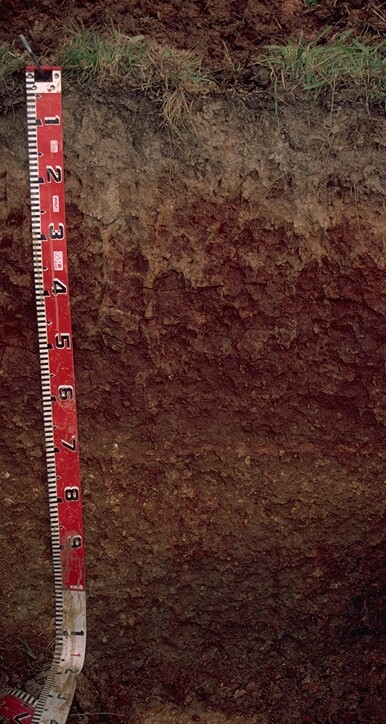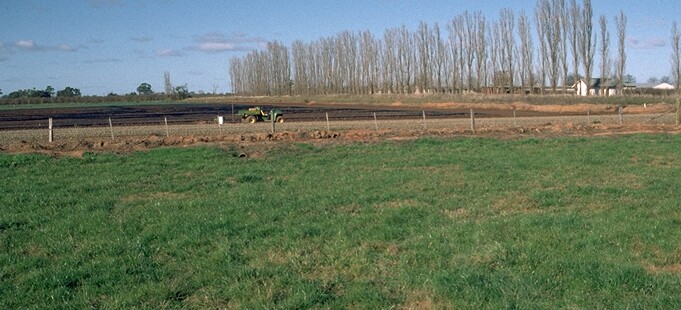GN27
| Property: ISIA Tatura | Australian Soil Classification: Calcic, Subnatric, Red SODOSOL |
| Northcote Factual Key: Dy 2.13 | Great Soil Group: red-brown earth |
| Soil Type: LEMNOS LOAM | |
| General Landscape Description: Level plain with prior stream activity. | |
| ||
Surface Soil
| A1 | 0-15 cm | Dark brown (10YR4/3) heavy clay loam; hardsetting surface when dry; moderate coarse blocky structure; contains a trace (< 2%) amount of manganese stains and ferromanganiferous nodules; pH 6.0; abrupt change to: |  GN27 Profile |
| Subsoil | |||
| B1 | 15-20 cm | Yellowish red (5YR5/8) and dark brown (10YR4/3) fine sandy clay; weak medium blocky structure; strong consistence, slightly moist; pH 6.9; clear change to: | |
| B21 | 20-70 cm | Yellowish red (5YR5/8) medium clay; moderate coarse blocky, breaking to moderate medium blocky structure; strong consistence, slightly moist; contains a few (5-10 %) manganese stains between 40-60 cm depth; pH 7.6; gradual change to: | |
| B22k | 70-90 cm | Strong brown (7.5YR5/6) [with some yellowish red (5YR5/8) mixing] light medium clay; moderate medium polyhedral, breaking to strong fine polyhedral structure; contains a few (5-10 %) carbonate/silica nodules (5-20 mm size); pH 9.0; clear change to: | |
| B23 | 90-110 cm | Pale brown (10YR6/3) with faint yellowish brown (10YR5/6) mottles; light medium clay; contains a common (10 %) amount of manganese stains and a trace (< 2%) amount of ferromanganiferous nodules (4 -10 mm size); pH 9.1 | |
Key Profile Features:
- Strong texture contrast between surface (A1) horizon and subsoil (B21) horizon.
- Calcareous horizon in deeper subsoil.
pH | Salinity Rating | |||
Surface soil (A1 horizon) | Moderately Acid | Very Low | Non-Sodic | None |
Upper subsoil (B21 horizon) | Slightly Alkaline | Very Low | Sodic | Complete |
Deep subsoil (at 1 m) | Very Strongly Alkaline | Low | Sodic | - |

Surface (A) Horizon
- The surface soil has a high fine sand (25%) and silt (34%) content. Organic matter is very important for maintaining aggregation in such soils and preventing slaking (by stabilising aggregates and reducing rates of wetting). The relationship between organic matter, tillage, stability of surface soil aggregates and infiltration have been demonstrated by numerous workers (eg. Cockcroft and Tisdall 1978, Tisdall et al 1978). Mason et al (1984) investigated the effects of irrigation and soil management for fodder crops on the root zone conditions of a Lemnos Loam near Kyabram. They concluded that the surface soil management systems had a major effect on aggregate stability. Minimum tillage, organic matter and irrigation management (eg. avoiding rapid wetting associated with flood irrigation) resulted in an increase in soil aggregate stability.
- The upper subsoil is sodic and has a low calcium:magnesium ratio (0.4). Strong dispersion occurs as a result. This could develop into a plough pan if excessively cultivated whilst in a moist to wet condition. Gypsum application with deep ripping may be an appropriate ameliorative technique. The depth to sodic subsoil horizons is an issue associated with landforming practices.
- The sodic and strongly dispersive subsoil will restrict root and water movement in the soil profile. Mikhail and Walbran (1974) studied the relationship between certain subsoil physical and chemical properties and subsoil friability (consistence) in a Lemnos Loam soils near Kyabram. They separated Lemnos Loam into three phases based on the field assessment of subsoil structure and friability ie. friable, semi-friable and non-friable. It was previously noted that the more friable the subsoil, the greater the performance of peach trees. The greater the friability and development of structure, the better the tree performance (as measured by butt circumference and tree height) and the deeper the penetration of roots into the subsoil. They found that exchangeable calcium contributes to a stronger and finer aggregated (ie. more friable) soil. Relatively high levels of silt, exchangeable sodium and magnesium contributed to a more weakly aggregated (ie. less friable) soil. The most friable soils had exchangeable calcium:magnesium ratios of greater than 1.0. Rengasamy et al (1984) suggest that when sufficient exchangeable sodium is present, a 15% reduction in hydraulic conductivity of red-brown earths could occur if the exchangeable calcium:magenesium ratio is less than 1.0, compared to a higher ratio.
- Deep ripping (in association with gypsum application) has been advocated by some workers as an ameliorative technique for soils such as these. A test strip would be a useful means for assessing likely benefits. Rengasamy et al (1984) suggest that for Goulburn Valley orchards, where the upper B horizon is restrictive to water penetration (and therefore creating waterlogging), gypsum should be cultivated to depths of up to 30 cm. Gypsum should also be applied at rates of up to three times that necessary for surface horizons.
Profile described by Paul Rampant and Mark Imhof (5/6/96).
REFERENCES
- Cockcroft, B. and Tisdall, J.M. (1978). Soil management, soil structure and root activity. In 'Modification of Soil Structure' (Ed. W.W. Emerson; R.D. Bond and A.R. Dexter) Ch. 51. pp. 387-391
- Mason, W.K; Small, D.R. and Pritchard, K.E. (1984). Effects of irrigation and soil management for fodder crops on root zone conditions in a red-brown earth. Aust. J. Soil Res. 22: 207-218.
- Mikhail, E.H and Walbran, W.I. (1974). Effect of subsoil friability in Lemnos loam on the growth of peach trees. Aust. J. Exp. Agric. and Animal Husb. Vol. 108-111
- Mikhail, E.H and Walbran, W.I. (1974). Relationship between certain physical and chemical properties and subsoil friability in Lemnos Loam. Aust. J. Exp. Agric. and Animal. Husb. 14:694-97
- Rengasamy, P; Greene, R.S.B; Ford, G.W, Jordan, P and Mehanni, A.H. (1984). Evaluation of the Gypsum Requirements of Red-Brown Earths. Research Project Series 192. Department of Agriculture.
- Tisdall, J.M; Cockroft, B. and Uren, N.C. (1978). The stability of soil aggregates as effected by organic materials, microbial activity and physical disruption. Aust. J. Soil res. 16: 9-17.


